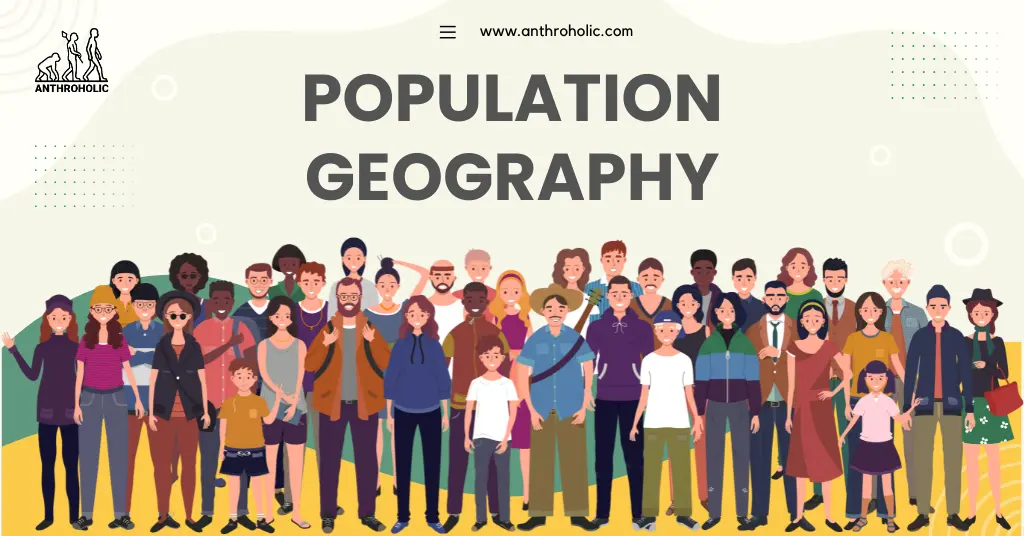AI Answer Evaluation Platform Live Now. Try Free Answer Evaluation Now
Population Geography
Population Geography is a sub-discipline of Human Geography, focusing on the spatial aspects of demography and the influences of population distribution, density, growth, and movement over the landscape. It serves as an interface between Geography and Demography, two dynamic fields addressing significant global issues such as urbanization, migration, and population aging [1].

The Concept of Population Geography
Population Geography encompasses various facets, each crucial in understanding global demographic patterns:
- Population Distribution: This refers to the arrangement or spread of people living in a particular area. It varies widely across the world due to factors such as climate, topography, and proximity to resources.
- Population Density: It measures the number of people per unit of land area, often represented per square kilometer or mile. It’s a crucial indicator for understanding population pressure on land and resources.
- Population Composition: This includes aspects such as age, sex, ethnicity, and socioeconomic status. It provides insights into the demographic structure of a region and the future trajectory of population change [2].
Factors Influencing Population Distribution
The uneven distribution of the global population is shaped by various factors:
- Physical Factors: These include elements like climate, terrain, and water availability. For example, dense populations are often found in fertile plains and river valleys, while desert and polar regions are sparsely populated.
- Socioeconomic Factors: Economic opportunities, like employment and trade, significantly influence population distribution. Urban areas often attract more population due to greater job opportunities and amenities.
- Political Factors: Stability, governance, and policies of a region also affect population distribution. For instance, conflict zones tend to have low population densities due to migration and displacement [3].
Population Density: Urban vs. Rural
Globally, there’s a considerable difference in population density between urban and rural areas. Urban areas, due to concentrated services and opportunities, generally have high population densities. In contrast, rural areas are characterized by lower densities because of agriculture-based lifestyles and the larger spread of land area.
| Region | Average Urban Density (people per km^2) | Average Rural Density (people per km^2) |
|---|---|---|
| Africa | 4000 | 25 |
| Asia | 6500 | 100 |
| Europe | 3000 | 50 |
| Americas | 3500 | 30 |
Population Composition and Demographic Transitions
A population’s composition, analyzed by age and sex structure, affects its demographic transitions—shifts from high birth and death rates to low birth and death rates over time. The four stages of demographic transition are:
- Pre-industrial Stage: High birth and death rates leading to slow population growth.
- Transitional Stage: Death rates start to fall, while birth rates remain high, resulting in rapid population growth.
- Industrial Stage: Birth rates start to fall, slowing down population growth.
- Post-industrial Stage: Both birth and death rates are low, leading to population stabilization [5].
Dynamics of Population Change
The primary dynamics affecting population change are fertility, mortality, and migration:
- Fertility: The incidence of childbearing in a country’s population. It is typically measured using the Total Fertility Rate (TFR), which estimates the average number of children a woman would have in her lifetime.
- Mortality: The incidence of death in a population. The Crude Death Rate (CDR), measuring the number of deaths per 1,000 people per year, is commonly used.
- Migration: The movement of people from one location to another, contributing to population change through either immigration (in-migration) or emigration (out-migration) [7].
The Role of Migration in Population Geography
Migration plays a vital role in shaping population distribution and composition. People move for various reasons, typically categorized as ‘push’ or ‘pull’ factors. Push factors, such as economic hardship or political instability, drive people away from a place. Conversely, pull factors attract individuals to certain areas, like better job opportunities or safety.
Migration patterns can be:
- Internal Migration: Movement within the same country or region.
- International Migration: Movement across national borders.
Both have significant impacts on the demographic patterns in both the origin and destination regions [8].
Population Aging
A significant trend in global demography is population aging. This refers to the increasing average age of the population, driven by declining fertility rates and increasing life expectancy. Population aging can affect societal structures, economic productivity, healthcare demands, and social security systems.
For instance, by 2050, the proportion of the world’s population over 60 years is expected to nearly double from 12% to 22%. This shift presents both challenges and opportunities for societies worldwide [9].
The Relevance of Population Geography in the 21st Century
In the current era of rapid globalization, demographic shifts have profound implications for socio-economic development, environmental sustainability, and geopolitical relations. The studies within Population Geography provide vital insights for:
- Urban planning and housing policies
- Social service allocation like healthcare and education
- Workforce and economic planning
- Sustainable development and environmental management
Understanding the patterns and dynamics of population change helps policymakers, planners, and businesses make informed decisions and plan for the future [10].
Conclusion
Population Geography, through its analysis of distribution, density, and composition, provides crucial insights into global demographic trends and their implications for society, environment, and economy. As demographic patterns evolve, understanding these trends will become increasingly vital for sustainable planning and policy-making [6].
References
[1] Clark, D. (2012). Population Geography: A General Approach
[2] Nash, M. (2015). The Study of Population: An Inventory and Appraisal
[3] Lewis, T. (2018). Human Geography: A Short Introduction
[4] United Nations, Department of Economic and Social Affairs, Population Division (2021). World Urbanization Prospects: The 2021 Revision
[5] Week, J. (2015). Population: An Introduction to Concepts and Issues
[6] Peters, G. (2017). Population Geography: Problems, Concepts, and Prospects
[7] Hugo, G. (2011). The Demographic Shift: From Fertility to Migration. Migration Policy Institute
[8] White, M., & Lindstrom, D. (2005). Internal Migration. In Handbook of Population
[9] World Health Organization (2018). Ageing and health
[10] Plane, D., & Rogerson, P. (2014). The Geographical Analysis of Population. In Handbook of Regional and Urban Economics



